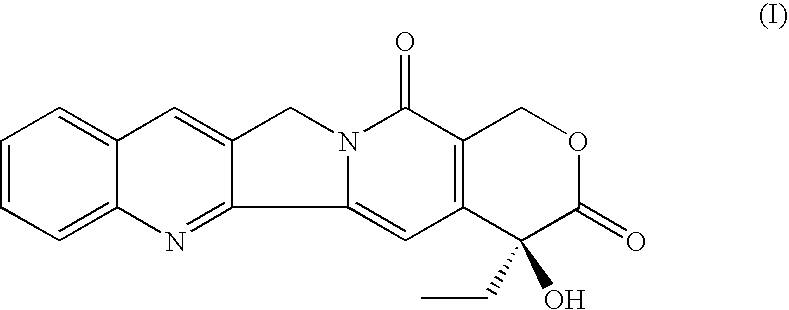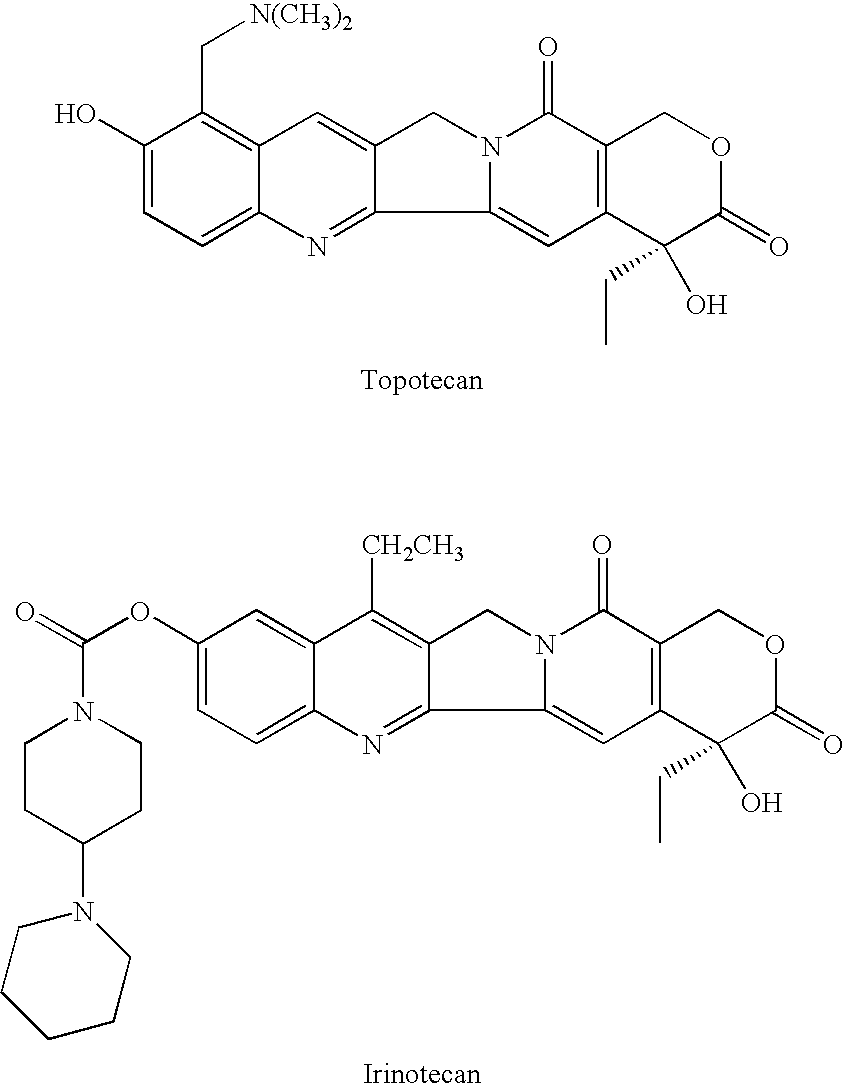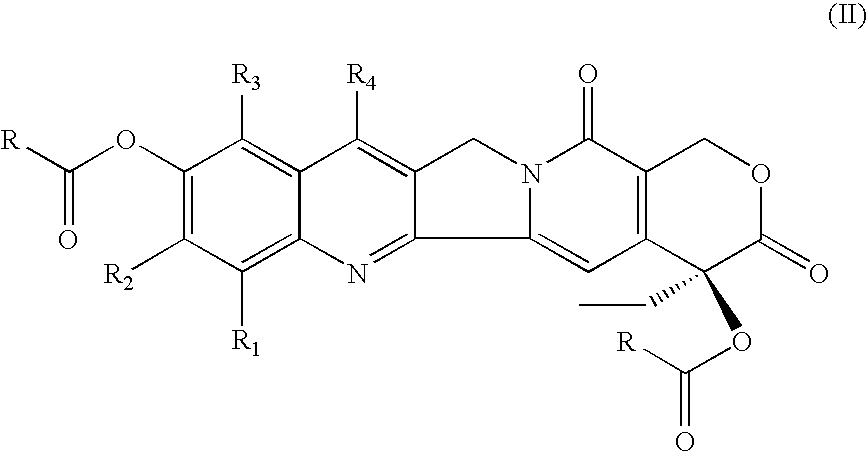Di-ester prodrugs of camptothecin, process for their preparation and their therapeutical applications
a technology of di-ester prodrugs and camptothecin, which is applied in the field of diester derivatives of camptothecin, can solve the problems of high toxicity of compounds, failure of early trials, and ineffective use of molecules for cancer treatment, so as to maintain the inherent anti-cancer activity of 10-hcpt, improve the biological life span and bioavailability of 10-hcpt, and reduce the toxicity of 10-hcpt
- Summary
- Abstract
- Description
- Claims
- Application Information
AI Technical Summary
Benefits of technology
Problems solved by technology
Method used
Image
Examples
example 1
[0101]This example illustrates the preparation of camptothecin 10,20-di-O-butyrate (CY1). To a round-bottomed flask was added 10-hydroxycamptothecin (3.0 g, 8.24 mmol), butyric anhydride (60 mL), followed by adding concentrated sulfuric acid (10 drops) dropwise at room temperature. The obtained mixture was stirred at about 100° C. for overnight. After cooling to room temperature, the mixture was poured into 350 mL petroleum ether portion by portion while stirring. After stirring for about 1 h, the crude product precipitated was collected by filtration. The crude product was then dissolved into DCM / H2O. The organic layer was washed with 5% NaHCO3, brine, dried (MgSO4) and concentrated. The residue was purified by flash silica gel chromatography eluted with THF / DCM (3-5%) to afford the white solid (3.7 g, 89%). Anal. Calcd for (C28H28N2O7+H)+ and (C28H28N2O7+Na)+: 505 and 527. Found: 505 and 527.
example 2
[0102]This example illustrates the preparation of camptothecin 10,20-di-O-isobutyrate (CY2). To a round-bottomed flask was added 10-hydroxycamptothecin (1.2 g, 3.29 mmol), isobutyric anhydride (40 mL), and followed by adding concentrated sulfuric acid (8 drops) dropwise at room temperature. The reaction mixture was stirred at 100° C. for 16 h. After cooling to room temperature, the mixture was poured into 250 mL petroleum ether portion by portion while stirring. After stirring for about 45 min, the crude product precipitated was collected by vacuum filtration. The crude product was partitioned with DCM (200 mL) and 5% NaHCO3 (80 mL), brine. The organic layer was washed with brine (1×100 mL) and dried over anhydrous MgSO4, filtered and concentrated in vacuo. The residue was purified by flash silica gel column chromatography (THF in DCM, 3-5%) to afford a white solid (1.59 g, 96%). Anal. Calcd for (C28H28N2O7+H)+ and (C28H28N2O7+Na)+: 505 and 527. Found: 505 and 527.
example 3
[0103]This example illustrates the preparation of camptothecin 10,20-di-O-hexonate (CY4). To a round-bottomed flask was added 10-hydroxycamptothecin (1.8 g, 4.94 mmol), hexanoic anhydride (50 mL), and followed by adding concentrated sulfuric acid (9 drops) dropwise at room temperature. The reaction mixture was stirred at 100° C. for 17 h. After cooling to room temperature, the mixture was poured into 300 mL petroleum ether portion by portion while stirring. After stirring for about 1 h, the crude product precipitated was collected by vacuum filtration. The crude product was partitioned with DCM (250 mL) and 5% NaHCO3 (80 mL), brine. The organic layer was washed with brine (1×100 mL) and dried over anhydrous MgSO4, filtered and concentrated in vacuo. The residue was purified by flash silica gel column chromatography (THF in DCM, 5-10%) to afford a white solid (2.38 g, 86%). Anal. Calcd for (C32H36N2O7+H)+ and (C32H36N2O7+Na)+: 561 and 583. Found: 561 and 583.
PUM
| Property | Measurement | Unit |
|---|---|---|
| diameter | aaaaa | aaaaa |
| diameter | aaaaa | aaaaa |
| diameter | aaaaa | aaaaa |
Abstract
Description
Claims
Application Information
 Login to View More
Login to View More - R&D
- Intellectual Property
- Life Sciences
- Materials
- Tech Scout
- Unparalleled Data Quality
- Higher Quality Content
- 60% Fewer Hallucinations
Browse by: Latest US Patents, China's latest patents, Technical Efficacy Thesaurus, Application Domain, Technology Topic, Popular Technical Reports.
© 2025 PatSnap. All rights reserved.Legal|Privacy policy|Modern Slavery Act Transparency Statement|Sitemap|About US| Contact US: help@patsnap.com



